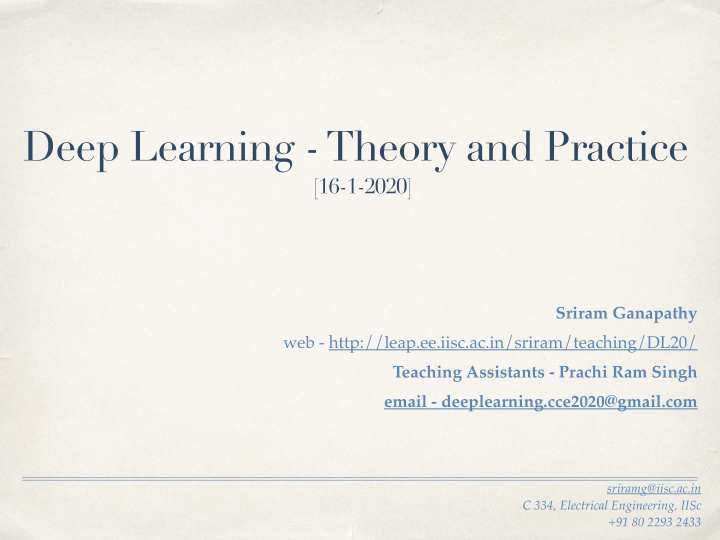



Deep Learning - Theory and Practice [16-1-2020] Sriram Ganapathy web - http://leap.ee.iisc.ac.in/sriram/teaching/DL20/ Teaching Assistants - Prachi Ram Singh email - deeplearning.cce2020@gmail.com sriramg@iisc.ac.in C 334, Electrical Engineering, IISc +91 80 2293 2433
What are signals ✤ Roland Priemer (1991). Introductory Signal Processing Anything that conveys information about attributes or behavior of underlying phenomenon ECG Signal Microsoft stock Music Signal Wikimedia
What are signals ✤ Roland Priemer (1991). Introductory Signal Processing Anything that conveys information about attributes or behavior of underlying phenomenon ✤ Common signals - (mapping from one domain to another) ✤ function of time (e.g. speech, music, ECG, financial data etc) ✤ function of space (e.g. images) ✤ joint function of time and space (eg. video signals)
What are sensory signals ✤ Sensory signals A sense is a physiological capacity of organisms that provides data for perception. ✤ Living organisms have multitude of sensations. ✤ Humans have the most complex perception system for these sensory signals. Wikimedia
What is learning ✤ Learning Act of acquiring new/reinforcing existing knowledge, behavior, skills ✤ Human learning starts even before birth. ✤ Fundamental to the existence and evolution. ✤ Machine learning ✤ Branch of artificial intelligence ✤ Attempts to use data to learn models that can predict/ classify. Wikimedia
Deep Learning Course ❖ Objectives ❖ Automatic discovery of patterns. ❖ Motivated by human capabilities to process real world signals. ❖ Mimicking/Extending/Replacing human functions. ❖ Branch of artificial intelligence. ❖ Classification and Regression.
Examples ❖ Domain Identification - Blog v/s Chat ? “I tried these Butterscotch Muffins today and they turned out so good. I had half the pack of butterscotch chips that I bought long back so wanted to use it up.” "Hey, it's Geoff from yesterday. How's it going? Hi there. Don't wanna bother you long, but you saw this video?"
Examples ❖ Did a Human or Machine write this ? “A shallow magnitude 4.7 earthquake was reported Monday morning five miles from Westwood, California, according to the U.S. Geological Survey. The temblor occurred at 6:25 AM, Pacific time at a depth of 5.0 miles.” “Kitty couldn’t fall asleep for a long time. Her nerves were strained as two tight strings, and even a glass of hot wine, that Vronsky made her drink, did not help her. Lying in bed she kept going over and over that monstrous scene at the meadow.” http://www.nytimes.com/interactive/2015/03/08/opinion/sunday/algorithm-human-quiz.html
Focus of the Course Models for Pattern Features Recognition Data Set ❖ Modeling the separation of data ❖ Deep Neural Networks.
What we will do in DL course ❖ Basics of Machine Learning ❖ Neural networks ❖ Deep learning methodologies and Architectures ❖ Implementing Deep models
Housekeeping ❖ What will help in Background learning ❖ Intro to probability ❖ Intro to linear algebra Requisite ❖ Coding ❖ Coding in Python ❖ We will use Keras and Torch for DL coding. Assignments - Theory + Implementation (50%) ❖ Mid-term (20%) ❖ Grading Finals (30 %) ❖
Content Delivery Theory Intuition and and Mathematical Analysis Foundation Implementation and Understanding
Rough Schedule ❖ 2 weeks - Basics of Machine Learning and Pattern Recognition. Matrix Algebra and Calculus ❖ 2 weeks - Logistic Regression - architecture, loss, learning using gradient descent. ❖ 2 weeks - Perceptron and Multi-layer perceptron, back propagation. ❖ 1 week - MidTerm Exam ❖ 2 weeks - Convolutional and recurrent neural networks. ❖ 2 weeks - Deep representation learning and deep unsupervised modeling. ❖ 1 week - Final Exam. ❖ 5 Assignments spread over 3 months (roughly one assignment every two weeks).
Recommend
More recommend